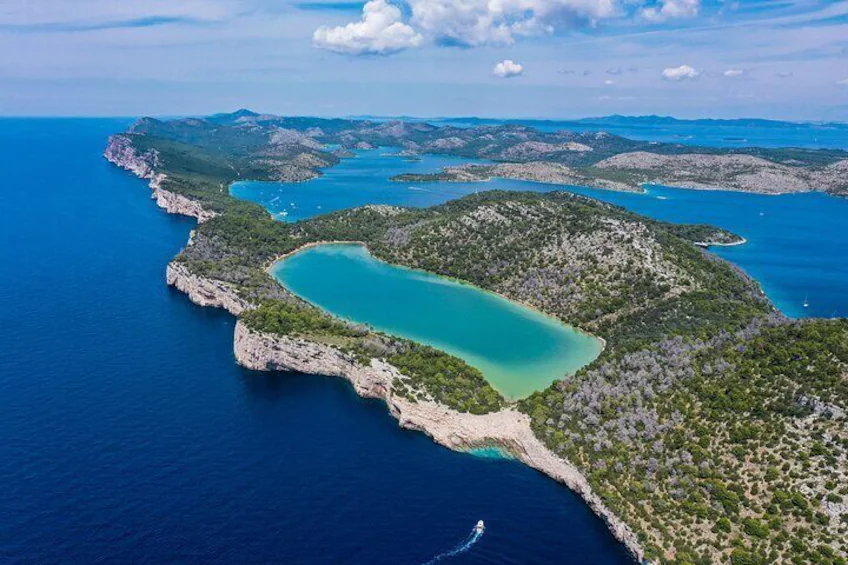Kornati National Park

Croatia's Kornati archipelago, sometimes called the Stomorski islands, is situated in the Šibenik-Knin County in the northern region of Dalmatia, west of Šibenik and south of Zadar. The Kornati are the densest archipelago in the Mediterranean water, spanning 35 kilometers (22 miles) and consisting of 89 islands, some large and others small, within a water area of roughly 320 square kilometers (124 square miles).They extend 13 km (8 miles) from northeast to southwest (from Gangarol to Mana) and northwest to southeast (from the island of Balabra to Samograd). The name of the largest island, Kornat, is the plural version of the name of the archipelago. Kornati has no permanent settlements. Landowners on the mainland use simple homes in protected coves like Vrulje, Kravjačica, Lavsa, and others as temporary shelter. The majority of landowners are from Dugi Otok and the island of Murter.The average water temperature is 14 to 15 °C (57 to 59 °F) in the winter and 22.8 °C (73.0 °F) in the summer. The average monthly temperature in January is 7.3 °C (45.1 °F), while in July it is 23.9 °C (75.0 °F).
In order to preserve the islands and their marine environment, the 89 southernmost of the 140-plus islands, islets, and reefs that make up the Kornati archipelago were designated as Nacionalni Park Kornati in 1980. The Donji Kornati, which consists of the island of Kornat and its surrounding islets, divided from the island of Piškera and its surrounding islets by a channel, is largely located inside the national park's boundaries.The national park includes 109 islands, of which 76 are less than 1 hectare in size. Of the total land surface area of Kornati, 62 km2 (24 sq mi), or 85%, is stony, and only 5% has been cultivated
The Kornati archipelago, which is 35 kilometers long and 13 kilometers wide and covers an area of about 320 square kilometers, is made up of 89 sporadic islets, both large and small.
Although there are a few extremely simple stone homes scattered here and there, the islets are rocky, dry, and have little fertile soil. They are also essentially deserted. Originally constructed as one-room shelters by shepherds and fishermen in the area, they are now frequently utilized as seasonal seafood restaurants or vacation getaways.Private sailing boats are the ideal means of exploring this breathtakingly beautiful coastline area, and Biograd Na Moru is the closest charter base. From Zadar or Sibenik on the mainland, one can easily take an excursion boat to the Kornati for a day trip. The four largest islands, Levrnaka, the second largest karst rock-area, Tarac, Svršata Vela island, Mana island, Piškera island, Panitula Vela island, the picturesque Lavsa Bay, the resort island Ravni Žakan, Smokvica Vela island, the Opat peninsula, Samograd island, the Purara reserve for marine life, Vrgada and Gangarol islands, the shallow channel Mala Proversa, the oval-shaped Taljurič island, Špinuta Bay, and Stivina Bay are the most significant locations on the Kornati islands.The names of the islands Babina Guzica and Kurba Vela, which in Croatian mean prostitution and buttocks, provide a chance to explain the numerous offensive names that are officially assigned to numerous locations across the Kornati archipelago. At the end of the 19th century, Austrian surveyors arrived to document the archipelago, but their local guides made fun of them by giving the different places obscene names.With a total size of 32.44 square kilometers (12.53 square miles), Kornat is the largest of the islands and makes up two-thirds of the park's land area. The island is only 2.5 km (2 mi) wide, despite being 25.2 km (15.7 mi) long. On the island of the same name, which is connected to the mainland by a drawbridge near the village of Tisno, the park is administered from the town of Murter.The Kornati Islands can be reached by:Any boat that can travel to sea, including your ownOne of the numerous native boatmen from the mainland who provide transport services
Numerous agencies provide this trip, which can be organized from Murter, Šibenik, Zadar, or another location along the Adriatic coast. The boat journey, a welcome drink, the admittance ticket, lunch, and a tour guide are all included in the price, which ranges from 35 to 40 euros per person.Without a doubt, Kornati would be Croatia's most brilliant gem if it were a crown! But this park is about more than just stunning views. In addition to showcasing Croatia's natural wonders, it provides stories about its rich history and culture.
By Admin
19 May 2025
.jpeg)
.jpeg)
.jpeg)


